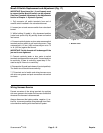
Problem Cause Correction
11. Engine does not stop when ig-
nition key is rotated to OFF posi-
tion.
Loose wire(s) in electrical system.
Ignition switch is malfunctioning.
Engine timing or carburetor out of
adjustment.
Check all connections and repair
as necessary.
Replace ignition switch.
Adjust carburetor or engine tim-
ing.
12. Battery does not charge. Open or missing fuse.
Loose wire(s) in electrical system.
Malfunctioning regulator or engine
charging circuit.
Faulty battery.
Install new fuse.
Check all connections and make
all necessary repairs.
Install new regulator or repair en-
gine charging circuit.
Test and replace if necessary.
Verify Interlock Operation
The interlock system is designed to stop the engine
when the operator is off of the seat, while the traction
selector is in the No. 1 or No. 2 position or the mow pedal
is pushed down. The system also prevents the engine
from starting in the same situation.
Do not disconnect or bypass the interlock
switches. Check the operation of the switches
to assure that the interlock system is operat-
ing correctly. If a switch is malfunctioning or
out of adjustment, adjust or replace it before
operating the machine. To assure maximum
safety, replace all interlock switches every
two years or 1000 hours, whichever comes
first.
To check the operation of the interlock switches:
1. Set on the seat and engage the parking brake. Push
the lift pedal down all the way and release it. Move the
shift selector to the No. 1 position and try to start the
engine. The engine should not crank. Move the shift
selector to the No. 2 position and try to start the engine.
The engine should not crank. If the engine did not crank
in either position, the traction switch is operating prop-
erly – proceed to step 2. If the engine cranked, refer to
Troubleshooting in this chapter.
2. Sit on the seat and engage the parking brake. Push
the lift pedal down all the way and release it. Move the
shift selector to the neutral (N) position and try to start
the engine. The engine should start and continue to run,
which means that the traction switch and mow/lift switch
is operating correctly - proceed to step 3. If the engine
cranked, but did not start, the problem is not in the
interlock system. If the engine did not crank, refer to
Troubleshooting in this chapter.
3. Sit on the seat and engine the parking brake. Move
the shift selector to the neutral (N) position. Push the
mow pedal down and try to start the engine. The engine
should not crank, which means the mow/lift switch is
operating correctly - proceed to step 4. If the engine
cranked, refer to Troubleshooting in this chapter.
4. Sit on the seat and engage the parking brake. Move
the shift selector to neutral (N). Push lift pedal down and
release it. Start the engine, release the parking brake
and drive the machine to an open area that is free of
debris and foreign objects. Keep all people, especially
children away from the front of the machine and out of
the area of operation. Move shift selector to neutral (N),
make sure the mow pedal is disengaged, set the throttle
control at half speed and engage the parking brake.
Hold the steering wheel, brace your feet on the foot deck
and brake pedal, and move the shift selector to the No.
1 position. Carefully lift off the seat; the engine should
stop. Repeat procedure with shift selector in No. 2
position. If engine stops while lifting off the seat with shift
selector in No. 1 and No. 2 positions, interlock system
is operating correctly. If engine does not stop, stop the
engine and correct the problem before operating the
machine. Refer to Troubleshooting in this chapter.
CAUTION
Troubleshooting Page 5 - 8 Greensmaster
®
3100


















